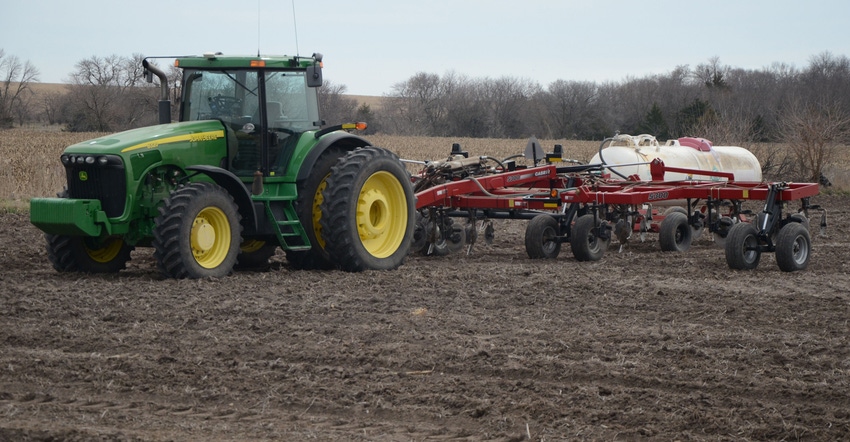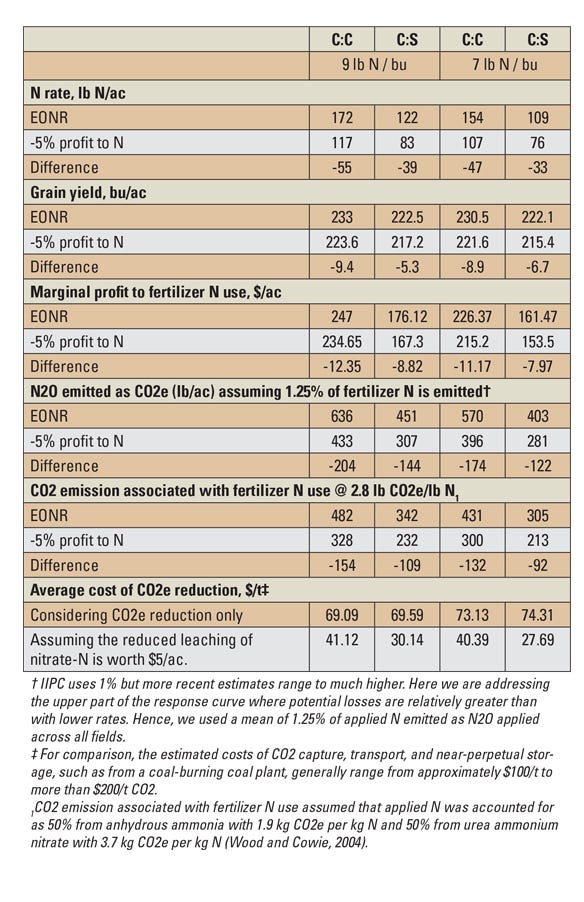February 11, 2019

By Charles Wortmann
Nitrogen losses to the environment are related to fertilizer nitrogen rate. The University of Nebraska-Lincoln nitrogen rate recommendations are intended to maximize profit per acre from fertilizer N use or to apply at the economically optimal N rate.
However, the changes in yield because of N rate are small near EONR and applying a few pounds of N per acre more or less than EONR has little effect on grain yield. Small changes in N rate have much less effect on the marginal profit due to fertilizer N use than on grain yield.
This raises the question as to how N losses might be reduced with a reduction in N rate that results in 5% less marginal profit to fertilizer N use. The objective of this article is to address this particularly for greenhouse gas emission expressed in carbon dioxide equivalents (CO2e). The practice would have effects on other N losses, especially due to leaching, but these are much more highly variable across Nebraska croplands than the nitrous oxide (N2O) and carbon dioxide (CO2) emissions associated with fertilizer N use.
The table gives a comparison, averaged across two fertilizer N costs, for fertilizer N applied at EONR and applied at a rate that results in 5% less marginal profit because of fertilizer N use. The mean reductions in N rates are 51 pounds N per acre and 31% for corn following corn, and 36 pounds N per acre and 31% for corn following soybean. This results in mean reductions in grain yield and marginal profits to fertilizer N use of 9.1 bushels per acre and $11.76 for corn following corn, and 6 bushels per acre and $8.40 for corn following soybean.

The mean corresponding effects on CO2e due to N2O emissions plus CO2 emissions associated with fertilizer N use are estimated to be reductions of 189 plus 143 for a total of 332 pounds CO2e per acre for corn following corn, and 133 plus 101 for a total of 234 pounds of CO2e per acre for corn following soybean. The costs to achieve these reductions are the loss in marginal profit because of fertilizer N use.
Therefore, the costs per ton of CO2e reduction are $71.11 for corn following corn and $71.95 for corn following soybean if no credit is given to the corresponding reductions in leached N and in other N losses. If the value of the reduced leaching and other N losses is $5 per acre, then the mean costs per ton of CO2e reduction are $40.76 for corn following corn and $28.92 for corn following soybean.
These results demonstrate that the practice of reducing N rates has the potential to be a highly cost-effective means of reducing CO2e emission to the atmosphere. For example, the total cost of CO2 capture, transport and near perpetual storage, such as capture for a coal-burning power plant, are estimated to range from $100 to more than $200 per ton CO2e.
These calculations for the effects of reduced N rate do not consider the eventual cost of reducing federal subsidies associated with yield. The calculations have not been extended to rain-fed corn because of inadequate data for representing the great diversity of rain-fed corn responses to N across Nebraska's cropland.
The reductions in N loss to other processes are not addressed because of these complexities. However, using Nitrogen Loss Assessment Tool (N-LAT) for Nebraska, NebGuide G2249, the mean leaching loss with the reduced N rate compared with the EONR was 40% less for corn following corn on occasionally flooded Invale loamy sand in Merrick County. This was with 43% of N spring-applied as anhydrous ammonia and 57% applied in-season as UAN. The reduced N rate results in an estimated 18% less N loss to denitrification for this loamy sand soil.
The benefits of such a reduced N rate practice to society and the cost in terms of reduced profit to the corn grower should be widely shared. The cost-effectiveness of the practice for reduced CO2e and N loss can be used in a quest for reallocation of some federal and other subsidies to crop production to compensate for the reduced profit associated with this practice.
Wortmann is a Nebraska Extension soil and nutrient management specialist.
This report comes from UNL CropWatch, which is solely responsible for the information provided and is wholly owned by the source. Informa Business Media and all its subsidiaries are not responsible for any of the content contained in this information asset.
You May Also Like




